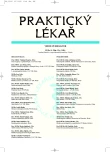Acute neuroborreliosis
Authors:
V. Vlková 1; D. Lábusová 2
Authors‘ workplace:
Oddělení klinické mikrobiologie a imunologie
Krajská nemocnice Liberec
Primář: MUDr. V. Kracík
1; Infekční oddělení
Krajská nemocnice Liberec
Primář: MUDr. L. Nedvědová
2
Published in:
Prakt. Lék. 2007; 87(7): 425-427
Category:
Case Report
Overview
The authors describe two cases of acute neuroborreliosis. The combined findings of these two differing cases serve as a reminder of certain aspects of the diagnosis of neuroborreliosis: the lack of erythema makes early detection difficult, the traditional concept of peripheral facial paralysis from the cold may delay correct diagnosis, detailed examination of cerebrospinal fluid is the most important diagnostic tool in suspected neuroborreliosis, absence of antibodies in the serum does not rule out neuroborreliosis, IgG and IgM antibodies may persist for several years following successful treatment.
Key words:
neuroborreliosis, case history, clinical diagnosis, serological diagnosis, ELISA, Western blot
Labels
General practitioner for children and adolescents General practitioner for adultsArticle was published in
General Practitioner

2007 Issue 7
Most read in this issue
- Acute neuroborreliosis
- Diagnosyis – iron deficiency
- Assessing oral health-related quality of life in Czech population
- Psychological aspects of acute pain
